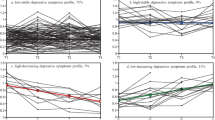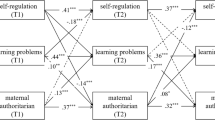Abstract
Asian American adolescents are often depicted as academically successful but psychologically distressed, a pattern known as the achievement/adjustment paradox. In a sample of 444 Chinese American adolescents (54 % females), we identified three distinct patterns of adjustment in early adolescence, middle adolescence, and emerging adulthood: the well-adjusted group, which was the largest, exhibited high achievement and low psychological distress; the poorly-adjusted group exhibited poor achievement and moderate distress; and the paradox group exhibited relatively high achievement and high distress. More than half of the adolescents remained in the same profile over time. Adolescents with supportive parents were more likely to stay well-adjusted, and those with “tiger” parents were more likely to stay in the paradox group over time. The present study focused on the critical role of parenting in early adolescence, highlighting variations in Chinese American adolescents’ adjustment in multiple domains over time.

Similar content being viewed by others
References
Abar, C. C., Jackson, K. M., & Wood, M. (2014). Reciprocal relations between perceived parental knowledge and adolescent substance use and delinquency: The moderating role of parent–teen relationship quality. Developmental Psychology, 50(9), 2176–2187. doi:10.1037/a0037463.
Armsden, G. C., & Greenberg, M. T. (1987). The Inventory of Parent and Peer Attachment: Individual differences and their relationship to psychological well-being in adolescence. Journal of Youth and Adolescence, 16, 427–454. doi:10.1007/BF02202939.
Barber, B. K. (1996). Parental psychological control: Revisiting a neglected construct. Child Development, 67, 3296–3319. doi:10.1111/1467-8624.ep9706244861.
Berndt, T. J., Cheung, P. C., Lau, S., Hau, K.-T., & Lew, W. J. F. (1993). Perceptions of parenting in mainland China, Taiwan, and Hong Kong: Sex differences and societal differences. Developmental Psychology, 29(1), 156–164. doi:10.1037/0012-1649.29.1.156.
Bronfenbrenner, U., & Morris, P. A. (2006). The bioecological model of human development. In R. M. Lerner & W. Damon (Eds.), Handbook of child psychology: Vol 1, Theoretical models of human development (6th ed., pp. 793–828). Hoboken, NJ: Wiley.
Chao, R. K. (1994). Beyond parental control and authoritarian parenting style: Understanding Chinese parenting through the cultural notion of training. Child Development, 65, 1111–1119. doi:10.2307/1131308.
Chua, A. (2011). Battle hymn of the tiger mother. New York: Bloomsbury Publishing.
Chua, S. N., Wong, N., & Koestner, R. (2014). Autonomy and controlling support are two sides of the same coin. Personality and Individual Differences, 68, 48–52. doi:10.1016/j.paid.2014.04.008.
Cicchetti, D., & Rogosch, F. A. (1996). Equifinality and multifinality in developmental psychopathology. Development and Psychopathology, 8, 597–600. doi:10.1017/s0954579400007318.
Collins, L. M., & Lanza, S. T. (2010). Latent class and latent transition analysis: With applications in the social, behavioral, and health sciences. Hoboken, NJ: Wiley.
Conger, R. D., & Elder, G. H, Jr. (1994). Families in troubled times. New York: DeGruyter.
Damon, W., Lerner, R. M., & Eisenberg, N. (2006). Handbook of child psychology, social, emotional, and personality development (Vol. 3). Hoboken: Wiley.
Dumas, T. M., Lawford, H., Tieu, T.-T., & Pratt, M. W. (2009). Positive parenting in adolescence and its relation to low point narration and identity status in emerging adulthood: A longitudinal analysis. Developmental Psychology, 45, 1531–1544. doi:10.1037/a0017360.
Eisenberg, N., Zhou, Q., Spinrad, T. L., Valiente, C., Fabes, R. A., & Liew, J. (2005). Relations among positive parenting, children’s effortful control, and externalizing problems: A three-wave longitudinal study. Child Development, 76, 1055–1071. doi:10.1111/j.1467-8624.2005.00897.x.
Elkins, S. R., Fite, P. J., Moore, T. M., Lochman, J. E., & Wells, K. C. (2014). Bidirectional effects of parenting and youth substance use during the transition to middle and high school. Psychology of Addictive Behaviors, 28(2), 475–486. doi:10.1037/a0036824.
Feinberg, M. E., Kan, M. L., & Hetherington, E. M. (2007). The longitudinal influence of coparenting conflict on parental negativity and adolescent maladjustment. Journal of Marriage and Family, 69(3), 687–702. doi:10.1111/j.1741-3737.2007.00400.x.
Fu, A. S., & Markus, H. R. (2014). My mother and me: Why tiger mothers motivate Asian Americans but not European Americans. Personality and Social Psychology Bulletin, 40, 739–749. doi:10.1177/0146167214524992.
Fuligni, A. J. (1997). The academic achievement of adolescents from immigrant families: The roles of family background, attitudes, and behavior. Child Development, 68, 351–363. doi:10.1111/j.1467-8624.1997.tb01944.x.
Garber, J., Robinson, N. S., & Valentiner, D. (1997). The relation between parenting and adolescent depression: Self-worth as a mediator. Journal of Adolescent Research, 12(1), 12–33. doi:10.1177/0743554897121003.
Graham, J. W. (2009). Missing data analysis: Making it work in the real world. Annual Review of Psychology, 60, 549–576. doi:10.1146/annurev.psych.58.110405.085530.
Hosmer, D. W., & Lemeshow, S. (2004). Applied logistic regression. Hoboken, NJ: Wiley.
Hsin, A., & Xie, Y. (2014). Explaining Asian Americans’ academic advantage over whites. Proceedings of the National Academy of Sciences, 111, 8416–8421. doi:10.1073/pnas.1406402111.
Janosz, M., Archambault, I., Morizot, J., & Pagani, L. S. (2008). School engagement trajectories and their differential predictive relations to dropout. Journal of Social Issues, 64(1), 21–40. doi:10.1111/j.1540-4560.2008.00546.x.
Kim, S. Y., Chen, Q., Wang, Y., Shen, Y., & Orozco-Lapray, D. (2013a). Longitudinal linkages among parent–child acculturation discrepancy, parenting, parent–child sense of alienation, and adolescent adjustment in Chinese immigrant families. Developmental Psychology, 49(5), 900–912. doi:10.1037/a0029169.
Kim, S. Y., Wang, Y., Orozco-Lapray, D., Shen, Y., & Murtuza, M. (2013b). Does “tiger parenting” exist? Parenting profiles of Chinese Americans and adolescent developmental outcomes. Asian American Journal of Psychology, 4, 7–18. doi:10.1037/a0030612.
Kroger, J., Martinussen, M., & Marcia, J. E. (2010). Identity status change during adolescence and young adulthood: A meta-analysis. Journal of Adolescence, 33(5), 683–698. doi:10.1016/j.adolescence.2009.11.002.
Lai, A. C., Zhang, Z.-X., & Wang, W.-Z. (2000). Maternal child-rearing practices in Hong Kong and Beijing Chinese Families: A comparative study. International Journal of Psychology, 35(1), 60–66. doi:10.1080/002075900399529.
Lamborn, S. D., Mounts, N. S., Steinberg, L., & Dornbusch, S. M. (1991). Patterns of competence and adjustment among adolescents from authoritative, authoritarian, indulgent, and neglectful families. Child Development, 62, 1049–1065. doi:10.2307/1131151.
Leadbeater, B., Thompson, K., & Gruppuso, V. (2012). Co-occurring trajectories of symptoms of anxiety, depression, and oppositional defiance from adolescence to young adulthood. Journal of Clinical Child & Adolescent Psychology, 41, 719–730. doi:10.1080/15374416.2012.694608.
Lee, S. J. (2009). Unraveling the “model minority” stereotype: Listening to Asian American youth (2nd ed.). New York, NY: Teachers College Press.
Lee, J., & Zhou, M. (2014). The success frame and achievement paradox: The costs and consequences for Asian Americans. Race and Social Problems, 6, 38–55. doi:10.1007/s12552-014-9112-7.
Luyckx, K., Tildesley, E. A., Soenens, B., Andrews, J. A., Hampson, S. E., Peterson, M., & Duriez, B. (2011). Parenting and trajectories of children’s maladaptive behaviors: A 12-year prospective community study. Journal of Clinical Child and Adolescent Psychology, 40, 468–478. doi:10.1080/15374416.2011.563470.
Maccoby, E. E., & Martin, J. A. (1983). Socialization in the context of the family: Parent–child interaction. In E. M. Hetherington (Ed.), Handbook of child psychology (4th ed., Vol. 4, pp. 1–101). New York, NY: Wiley.
Meeus, W. (2011). The study of adolescent identity formation 2000–2010: A review of longitudinal research. Journal of Research on Adolescence, 21, 75–94. doi:10.1111/j.1532-7795.2010.00716.x.
Meeus, W., Van de Schoot, R., Klimstra, T., & Branje, S. (2011). Personality types in adolescence: Change and stability and links with adjustment and relationships: A five-wave longitudinal study. Developmental Psychology, 47(4), 1181–1195. doi:10.1037/a0023816.
Muthén, L. K., & Muthén, B. O. (1998–2015). Mplus user’s guide (7th ed.). Los Angeles, CA: Muthen & Muthen.
Nolen-Hoeksema, S., & Watkins, E. R. (2011). A heuristic for developing transdiagnostic models of psychopathology explaining multifinality and divergent trajectories. Perspectives on Psychological Science, 6, 589–609. doi:10.1177/1745691611419672.
Nylund, K., Asparouhov, T., & Muthén, B. O. (2007). Deciding on the number of classes in latent class analysis and growth mixture modeling: A Monte Carlo simulation study. Structural Equation Modeling: An Interdisciplinary Journal, 14, 535–569. doi:10.1080/10705510701575396.
Qin, D. B. (2008). Doing well vs. feeling well: Understanding family dynamics and the psychological adjustment of Chinese immigrant adolescents. Journal of Youth and Adolescence, 37, 22–35. doi:10.1007/s10964-007-9220-4.
Qin, D. B., Rak, E., Rana, M., & Donnellan, M. B. (2012). Parent–child relations and psychological adjustment among high-achieving Chinese and European American adolescents. Journal of Adolescence, 35, 863–873. doi:10.1016/j.adolescence.2011.12.004.
Radloff, L. S. (1977). The CES-D Scale: A self-report depression scale for research in the general population. Applied Psychological Measurement, 1, 385–401.
Robinson, C. C., Mandleco, B., Olson, S. F., & Hart, C. H. (1995). Authoritative, authoritarian, and permissive parenting practices: Development of a new measure. Psychological Reports, 77, 819–830. doi:10.2466/pr0.1995.77.3.819.
Ryan, C. L., & Siebens, J. (2012). Educational attainment in the United States: 2009. Washington, DC: U.S. Census Bureau.
Shaffer, J. P. (1995). Multiple hypothesis testing. Annual Review of Psychology, 46, 561–584. doi:10.1146/annurev.ps.46.020195.003021.
Snyder, T. D., & Dillow, S. A. (2010). Digest of education statistics 2009 (NCES 2010-013) National Center for Education Statistics, Institute of Education Sciences. Washington, DC: U.S. Department of Education.
Soenens, B., Vansteenkiste, M., Luyten, P., Duriez, B., & Goossens, L. (2005). Maladaptive perfectionistic self-representations: The mediational link between psychological control and adjustment. Personality and Individual Differences, 38(2), 487–498. doi:10.1016/j.paid.2004.05.008.
Specht, J., Egloff, B., & Schmukle, S. C. (2011). Stability and change of personality across the life course: The impact of age and major life events on mean-level and rank-order stability of the Big Five. Journal of Personality and Social Psychology, 101, 862–882. doi:10.1037/a0024950.
Sroufe, L. A., & Rutter, M. (1984). The domain of developmental psychopathology. Child Development, 55, 17–29. doi:10.2307/1129832.
Suárez-Orozco, C., Bang, H. J., & Onaga, M. (2010). Contributions to variations in academic trajectories amongst recent immigrant youth. International Journal of Behavioral Development, 34, 500–510. doi:10.1037/a0018201.
Teubert, D., & Pinquart, M. (2010). The association between coparenting and child adjustment: A meta-analysis. Parenting: Science and Practice, 10(4), 286–307. doi:10.1080/15295192.2010.492040.
U.S. Census Bureau. (2000a). Profile of selected economic characteristics. Retrieved April 29, 2015 http://factfinder.census.gov/faces/tableservices/jsf/pages/productview.xhtml?pid=DEC_00_SF4_DP3&prodType=table
U.S. Census Bureau. (2000b). Profile of selected social characteristics. Retrieved April 29, 2015 http://factfinder.census.gov/faces/tableservices/jsf/pages/productview.xhtml?pid=DEC_00_SF4_DP2&prodType=table
Zhou, M., & Kim, S. S. (2006). Community forces, social capital, and educational achievement: The case of supplementary education in the Chinese and Korean immigrant communities. Harvard Educational Review, 76, 1–29.
Zwick, R., & Sklar, J. C. (2005). Predicting college grades and degree completion using high school grades and SAT scores: The role of student ethnicity and first language. American Educational Research Journal, 42(3), 439–464. doi:10.3102/00028312042003439.
Acknowledgments
Support for this research was provided through awards to Su Yeong Kim from (1) Eunice Kennedy Shriver NICHD 5R03HD051629-02. (2) Office of the Vice President for Research Grant/Special Research Grant from the University of Texas at Austin. (3) Jacobs Foundation Young Investigator Grant. (4) American Psychological Association Office of Ethnic Minority Affairs, Promoting Psychological Research and Training on Health Disparities Issues at Ethnic Minority Serving Institutions Grant. (5) American Psychological Foundation/Council of Graduate Departments of Psychology, Ruth G. and Joseph D. Matarazzo Grant. (6) California Association of Family and Consumer Sciences, Extended Education Fund. (7) American Association of Family and Consumer Sciences, Massachusetts Avenue Building Assets Fund, and (8) Eunice Kennedy Shriver NICHD 5R24HD042849-13 grant awarded to the Population Research Center at The University of Texas at Austin.
Author contributions
SYK conceived of the study, participated in its design and coordination and drafted portions of the manuscript; YW performed the statistical analysis and drafted portions of the manuscript; YS and YH participated in the interpretation of the data and drafted portions of the manuscript. All authors read and approved the final manuscript.
Conflict of interest
The authors report no conflict of interests.
Author information
Authors and Affiliations
Corresponding author
Rights and permissions
About this article
Cite this article
Kim, S.Y., Wang, Y., Shen, Y. et al. Stability and Change in Adjustment Profiles Among Chinese American Adolescents: The Role of Parenting. J Youth Adolescence 44, 1735–1751 (2015). https://doi.org/10.1007/s10964-015-0303-3
Received:
Accepted:
Published:
Issue Date:
DOI: https://doi.org/10.1007/s10964-015-0303-3




